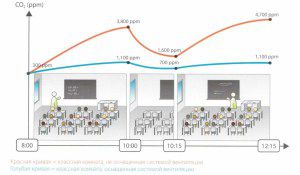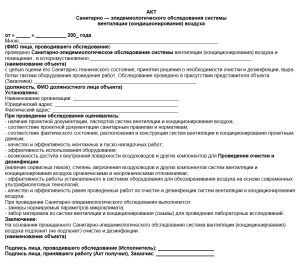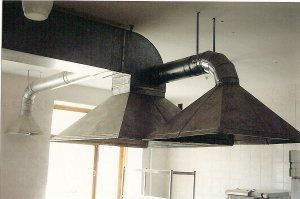Ventilation in schools and kindergartens provides a healthy microclimate necessary for the well-being and proper education of children. The focus is on the microclimate in classrooms, bedrooms, gyms. All ventilation parameters specified in inspection reports are regulated by standards SNiP 31-06-2009 and SanPiN.
Sanitary and hygienic audits are carried out by employees of the Sanitary and Epidemiological Service. One sample of the act of checking the efficiency of ventilation remains in the educational institution, the other in the archives of the SES service.
Checking ventilation systems

The efficiency of the systems is determined before the commissioning of a new facility, as well as annually in August before the start of the school year.
A school that has not submitted an act of checking the efficiency of ventilation to Rospotrebnadzor does not have the right to open a new academic year. The task of supervision is to prevent malfunctions in the operation of ventilation systems, as well as to detect existing malfunctions in time. The results are entered in the kindergarten inspection report or in the school inspection report.

Preventive sanitary supervision is necessary both when commissioning a new kindergarten or school, and when replacing ventilation equipment after repairs. During the inspection of the ventilation system, an act of the established form is drawn up.
Control over the condition of ventilation equipment in laboratories and chemical rooms can be carried out once every 3 months, since hazardous and harmful substances can be released into the air here.
Current control is carried out by the method of measurements using special equipment.
In some cases, it is necessary to attach photos taken on site and indicating the condition of the equipment to the certificate for checking the ventilation ducts. The established sample of the act of checking the efficiency of ventilation is filled in.
Forms of acts for checking the efficiency of ventilation are not classified as strict reporting.
Kindergarten ventilation check
According to the requirements of regulatory enactments, kindergartens are located in separate buildings. Ventilation in bedrooms and playrooms is provided in a natural way (corner or through ventilation through open vents). The effectiveness of this method in each specific case is checked by the employees of Rospotrebnadzor with the obligatory entry of the results into the act of checking the efficiency of ventilation.
Room humidity accounting
Humidity is one of the most important indicators of the microclimate of a preschool institution. Therefore, this indicator is always noted in the acts of inspection of the ventilation of the kindergarten. Too dry air negatively affects the respiratory system of children. Whereas excessive moisture leads to the development of mold, which causes allergies and asthma. Therefore, when checking the operation of ventilation in a kindergarten, humidity is necessarily determined and the result is entered into the act.
Control over the condition of the air exchange systems of kindergartens does not provide for filling out a separate form for the inspection of ventilation ducts. All the necessary data for checking the degree of purity and efficiency of their work are entered into one general act of the standard sample.
School ventilation check
The schools use a mixed ventilation system.To provide fresh air in classrooms, teachers' rooms, library and corridors, vents are equipped, exhaust air is removed through ventilation ducts in bathrooms. In the course of control measurements, the performance indicators of natural ventilation are entered into acts.
Laboratories, assembly halls, workshops, gyms and canteens require forced air outflow. Clean air enters the premises through open vents in the corridors and changing rooms. The exhaust is provided forcibly, by exhaust fans, through the ventilation ducts. The ratio of the supply to the extract should be 2.5: 1.5 on average. The intensity of the system and the cleanliness of the air ducts are checked, the results are recorded in the school ventilation inspection report.
Premises with enhanced ventilation
Fume hoods and forced air extraction are installed in laboratories and chemistry rooms. The compliance of the capacity of the exhaust equipment with the established standards is monitored and recorded by acts of inspection of smoke and ventilation ducts.

Enhanced air exchange is also necessary in the catering room, where a lot of heat and moisture is released during the cooking process. Usually it is forced ventilation of the supply and exhaust type.
The inflow goes into the dining room, at the rate of 20 cubic meters of air per hour per seat. Exhaust air is drawn from the kitchen area. The rate of air exchange in the kitchen is measured during the audit and entered into the act of checking the ventilation efficiency.
If air and heat curtains are installed at the entrance to the school (which is typical for large schools), temperature and humidity indicators are measured in the vestibules and recorded in the ventilation inspection reports.
Recirculation of air is prohibited when using air heating systems in schools. It is forbidden to use asbestos-cement pipes as air ducts. The detected violations are entered according to the sample in the act of checking the ventilation ducts.








